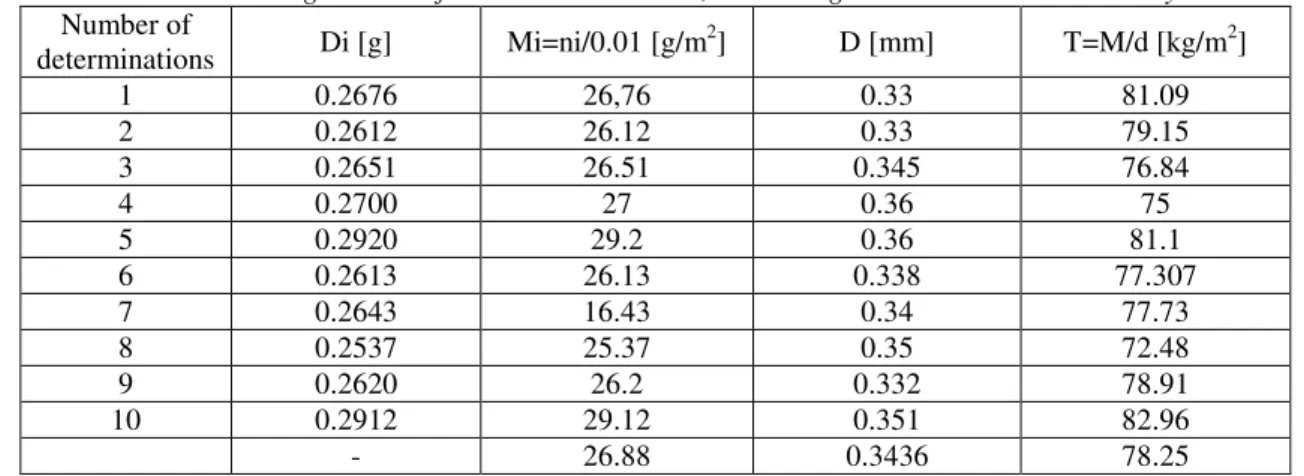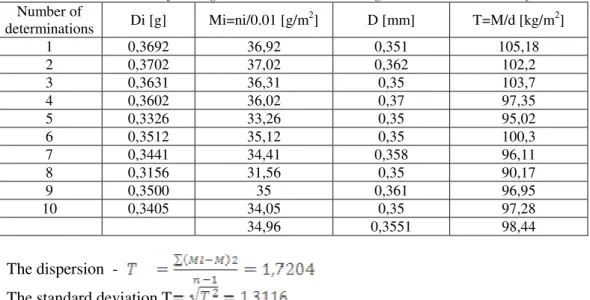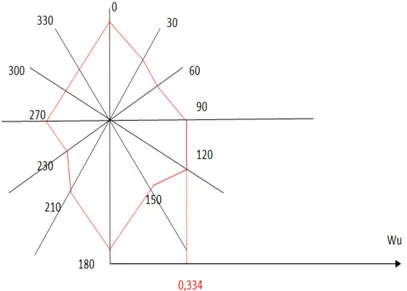ANNALS OF THE UNIVERSITY OF ORADEA FASCICLE OF TEXTILES, LEATHERWORK
STUDY OF UNCONVENTIONAL TEXTILES USED AS INSERTION
FOR CLOTHES IN TERMS OF ITS DYNAMIC TENSILE STREGHT
OANA Dorina
1, OANA Ioan-Pavel
1, KENYERES Florentina
11
University of Oradea, Romania, Department of Textiles – Leatherwork and Industrial Management in Faculty of Energy Engineering and Industrial Management, Str. B.Şt Delavrancea nr.4, 410087, Oradea, Bihor, Romania,
E-mail:textile@uoradea.ro
Corresponding author: Oana. Ioan-Pavel, E-mail: oanaioanpavel@yahoo.com
Abstract: Unconventional textiles are manufactured different from those obtained by the classic spinning weaving and knitting. They are obtained by mechanical or chemical consolidation of a textile backing up of fibrous layers or combinations of layers of fiber and yarn, fabrics and yarns, fabrics or knitted fabrics and fibers.
For the apparel industry has expanded the use of unconventional fabrics especially in auxiliary materials they replace traditional materials such as woven tassel and buckram.
Application of reinforcement layers have very important role in increasing the stability of form and material exploitation basic characteristics.
Using unconventional fabrics used as insertions for clothing presents a desosibit advantage in terms of possible replacement joints bonded by heat sealed seam, thus saving time and using technology more accessible.
For unconventional fabrics used as auxiliaries in the apparel industry is usually determined flexural stiffness, tensile strength, resistance to repeated stretches but more efficient in terms of proximity to the real conditions of the clothing is dynamic tensile resistance.
Unconventional textile materials have a certain anisotropy in terms of the performed measurements. So, we followed the conducted research to highlight the anisotropy of several samples and characterization of best of unconventional materials in this regard, to be used under conditions effective as clothing industry.
Key words: anisotropy, coefficient of variation, clothing, dispersion, bulk density.
1.
INTRODUCTION
Article 1 contains 75% polyester fibers, 1.5 dtex / 38mm and 25% adhesive solution Romacril LN2 [1, 2]. In Table 1 are shown the average weight, average thickness and bulk density.
Table 1. Average values of mass determinations, the average thickness and bulk density.
Number of
determinations Di [g] Mi=ni/0.01 [g/m
2
] D [mm] T=M/d [kg/m2]
1 0.2676 26,76 0.33 81.09
2 0.2612 26.12 0.33 79.15
3 0.2651 26.51 0.345 76.84
4 0.2700 27 0.36 75
5 0.2920 29.2 0.36 81.1
6 0.2613 26.13 0.338 77.307
7 0.2643 16.43 0.34 77.73
8 0.2537 25.37 0.35 72.48
9 0.2620 26.2 0.332 78.91
10 0.2912 29.12 0.351 82.96
(1) T – the standard deviation
(2)
The coefficient of variation: Cv = 4,202%
Article 2 is an unconventional textile reinforced with curable powder respectively a
copolyamide thermo ADEROM. [1] The weight, thickness and apparent density are shown in Table 2. Table 2 The values of average mass determinations, average thickness and bulk density.
Number of
determinations Di [g] Mi=ni/0.01 [g/m 2
] D [mm] T=M/d [kg/m2]
1 0,3692 36,92 0,351 105,18
2 0,3702 37,02 0,362 102,2
3 0,3631 36,31 0,35 103,7
4 0,3602 36,02 0,37 97,35
5 0,3326 33,26 0,35 95,02
6 0,3512 35,12 0,35 100,3
7 0,3441 34,41 0,358 96,11
8 0,3156 31,56 0,35 90,17
9 0,3500 35 0,361 96,95
10 0,3405 34,05 0,35 97,28
34,96 0,3551 98,44
The dispersion - The standard deviation T
The coefficient of variation is Cv=3,75%
It was observed that the article 2 we have a coefficient of variation of mass lower than for Article 1, so it can be concluded that it has a better uniformity in terms of unconventional fabric and adhesive.
Submission of ADEROM polyamide thermal adhesive powders can be traced in the technological process adopted in Figure 1.[3]
Fig. 1: The technological process
THERMAL ADHESIVE ADEROM
UNCONVENTIONAL
Deposition Thermal glue powder on unconventional textile - feeding on unconventional textile
ANNALS OF THE UNIVERSITY OF ORADEA FASCICLE OF TEXTILES, LEATHERWORK
Article 3 is a PULVOTEX type 4 with a low mass per unit area. Realizing some samples of 10/10 cm, can cause weight variation, thickness and bulk density, then calculating the coefficient of variation for determining masses m2.
Table 3: The average mass determinations, the average thickness and bulk density
Number of determinations
Di [g] Mi=ni/0.01 [g/m2]
D [mm] T=M/d [kg/m2]
1 0,3310 33,1 0,31 100,32
2 0,3318 33,18 0,301 110,2
3 0,3414 33,14 0,33 103,4
4 0,3135 33,35 0,3342 91,66
5 0,3546 33,46 0,296 119,7
6 0,3302 33,02 0,302 109,3
7 0,3251 33,51 0,34 98,55
8 0,3354 33,54 0,35 95,82
9 0,3209 33,09 0,31 103,5
10 0,3422 33,22 0,31 110,38
33,16 0,317 104,31
The dispersion - The standard deviation T
The coefficient of variation is Cv=3,499%
Comparing the three coefficients of variation observed that Article 3 presents the lowest coefficient of variation, so the homogeneous spreading of the adhesive on the surface unconventional, so by filing a pasty adhesive to obtain a homogeneous mass insertion. [4,5,6]
2.
THE DYNAMIC TENSILE TESTING OF UNCONVENTIONAL
MATERIALS
2.1 The dynamic tensile test of unconventional material in Article 1
Respecting operating mode, we obtain the following values for the angle β, for an angle α=880 Table 4: The dynamic tension values obtained for Article 1
Nr.det/dir 00-1800 300-1200 600-2400 900-2700 1200-3000 1500-3300
1 83 85,5 86,5 85,5 85,5 85
2 84 86 86,3 85,2 85 84,5
3 83,5 86,5 86 85 85 83,8
4 85 84,5 86,6 87 85,2 84,6
5 84 86 86,2 85 85,1 85,5
The obtained values shown in Table 4 will calculate the work in dynamic tensile rupture stress values summarized in Table 5.
(3)
G=42,63 N, R=0,22 m, α=880
Table 5: The values for the mechanical work at rupture of dynamic tensile stress
variation of the directions that have the highest values of mechanical work 0-180 and 150-330 respectively at rupture. By drawing polar diagram there is a relatively uniform distribution in all directions, therefore a relatively low degree of anisotropy.
Fig.2: The polar diagram for Article 1
2.2
The tensile test of unconventional dynamic material for Article 2
Applying the same procedure as in Article 1, we obtain values for the angle β, for the same angle α=880 previously determined.
Table 6: Values for the angle β
nr.det/dir 00-1800 300-1200 600-2400 900-2700 1200-3000 1500-3300
1 82 86 86,2 86,9 87,2 86
2 79,5 86,5 86,5 87 87 85,9
3 80 86 87 86,4 86,2 87
4 79,5 86,6 86 87 86,5 86,1
5 83 87 86,7 87,1 87 86
The obtained values will calculate the mechanical work at rupture for the dynamic tensile stress, the values are summarized in Table 7.
Table 7: The values of mechanical work at ruptures for dynamic tensile loads
nr.det/dir 00-1800 300-1200 600-2400 900-2700 1200-3000 1500-3300
1 0,9779 0,3269 0,2942 0,1917 0,1308 0,3269
2 1,38 0,2452 0,2452 0,1635 0,1635 0,3432
3 0,32 0,3269 0,1635 0,2789 0,2942 0,1632
4 1,3818 0,2288 0,3269 0,1635 0,2452 0,3105
5 0,8156 0,1635 0,2125 0,1471 0,1635 0,3269
Wu 1,17 0,2582 0,2484 0,188 0,1944 0,3942
T2 0,0673 0,0048 0,036 0,0012 0,036 0,0043
T 0,2595 0,0697 0,0606 0,0354 0,0606 0,0662
Cv 22,14% 26,99 24,39 18,7 30,3 22,5
ANNALS OF THE UNIVERSITY OF ORADEA FASCICLE OF TEXTILES, LEATHERWORK
Fig.3: The polar diagram for Article 2
2.3 Testing the dynamic unconventional material at tensile for Article 3
Applying the same procedure as in Article 1 and 2, we obtain values for the angle β, α = 880 for the same angle previously determined.
Table 8: Value for the angle β
nr.det/dir 00-1800 300-1200 600-2400 900-2700 1200-3000 1500-3300
1 61 86 86,1 87 87,8 86
2 60,2 86,8 86 86 88 85
3 61 86,2 86,3 86,8 87 84,8
4 60,8 86,5 86,5 86,7 87,3 86,1
5 62 87 86,3 86,4 87,5 86,2
With the values obtained will calculate the mechanical work for rupture for dynamic tensile stress values are summarized in Table 9.
Table 9: Values for the mechanical work to rupture of dynamic tensile stress
nr.det/dir 00-1800 300-1200 600-2400 900-2700 1200-3000 1500-3300
1 4,219 0,3269 0,3105 0,1635 0,0327 0,3269
2 4,333 0,1962 0,3269 0,2452 0 0,49008
3 4,219 0,2942 0,2779 0,1962 0,1635 0,5439
4 4,24 0,2452 0,2452 0,2125 0,1144 0,3105
5 4,075 0,1635 0,2779 0,2615 0,0817 0,2942
Wu 4,217 0,2452 0,2876 0,2157 0,0784 0,3897
T2 0,0068 0,0045 0,008 0,0012 0,0033 0,0096
T 0,82 0,067 0,0284 0,0348 0,05798 0,0982
Cv 1,95% 27,47% 9,9% % 73,9% 25,2%
Fig.4: The polar diagram for Article 3
3. CONCLUSIONS
The analysis of polar diagrams made from measurements performed can be seen that there are some directions for dynamic tensile strength value is high. Although it is unusual that the deposition thermal resistance of materials to grow adhesives are directions in which the resistance value falls below the average resistance of Article 1 300-1200 oblique directions; 1200-3000; 150-3300 900-2700 transverse direction. This is explained by the fact that the fibers are mainly oriented in the longitudinal direction and supported thermoadhesive unconventional arrangement when it is subjected to dynamic traction, the emergence of lines of least resistance through the points of submission of thermal adhesives.
Article 3 is noted for extreme values, reaching both maximum and minimum tensile strength as dynamic, characterized by a high degree of anisotropy. Its use in the apparel industry would be recommended only if it can be used only 00-1800 direction that is where we have a very high dynamic tensile strength. Although consumption of material would be quite high due respect this direction, it is recommended especially for outdoor clothing products intended for manners that the circumstances in which it carries, are frequently subjected to various stresses that act very quickly.
REFERENCES
[1] D. Bordeianu,“Tehnologii generale în filatură - ţesătorie- Materiale textile neconvenţionale”, Editura Universităţii din Oradea, 2006
[2] D. Bordeianu, “Fibre textile”, Editura Universităţii din Oradea, 2006
[3] C. Loghin, “Tehnologiişi utilaje în confecţii textile”, Editura Performantica Iaşi, 2003 [4] S. Mitu, “Bazele tehnologiei confecţiilor”, Editura Gh. Asachi Iaşi,1998
[5] S. Mitu, “Bazele tehnologiei confecţiilor-îndrumar de laborator”, Editura Gh. Asachi Iaşi,1998


![Table 3: The average mass determinations, the average thickness and bulk density Number of determinations Di [g] Mi=ni/0.01 [g/m2] D [mm] T=M/d [kg/m 2 ] 1 0,3310 33,1 0,31 100,32 2 0,3318 33,18 0,301 110,2 3 0,3414 33,14 0,33 103,4 4](https://thumb-eu.123doks.com/thumbv2/123dok_br/18404697.359093/3.892.196.698.223.474/table-average-determinations-average-thickness-density-number-determinations.webp)

